Rumble Pie #24
Everything Earth
ALRIGHT, WE'VE GONE AROUND the world in eighty lines, showing you ultra-eco homes made from earth in every continent, climate, and culture, in The Healthiest Housing in the World. Then we flew to Portland, Oregon, the capital city of cob, to learn how civic activists are building benches made from mud to turn public spaces into community places, in Intersections and Interventions. And now to conclude our trilogy of blogs about cob construction, we will conduct a survey of some of the other structures that can be built from mud, that are bigger than benches, but not quite full-fledged houses. We hope to inspire you to re-imagine your landscaping to include all sorts of earthen structures that are both utilitarian and aesthetically pleasing. The Green Apple team has lots of experience with cob construction, and we are happy to include a cob structure as part of an overall re-design for your garden. And if you get so excited by it that you want to get in on the action yourself, as many people do, we're happy to instruct you and your family and friends in cob construction so you can put together all kinds of cool cob projects.
THE FIRST CATEGORY THAT we will examine is the community newsstand. Maybe your neighbourhood has an actual newspaper that is distributed locally, like the Annex Guardian or the North York Mirror. Maybe it doesn't -- but that doesn't mean that you can't start one up! Whether it's lost dog notices, yard sale announcements, advertisements for community activities, or just a forum for communication -- every street corner could benefit from one of these. There are a few different variants on the newsstand; you could build a bulletin board that's encased in a box and protected from the elements, where flyers can be affixed with thumbtacks (see first photo below). Or you could have an actual newspaper dispenser made out of cob where passers-by are encouraged to open the door and pick up a copy (see second photo below). In Oakland, California, I installed a couple of blackboards so that people could interact textually in the public space. It was widely used and much appreciated.


NEXT ON THE LIST IS the humble cob courtyard wall. I don't mean a retaining wall to hold back an embankment, but a free-standing half-wall that separates your garden into quadrants. This may not be applicable to everyone out there; if your yard is small to begin with, there's no point in carving it up into smaller sections. But for those with large gardens, it may make sense to create smaller pockets, little sitting areas that are more intimate, partitioning play areas from perennials. Or depending on what borders on your property and the amount of traffic you get regularly, you may want to create some kind of buffer zone that shields you from the sights and sounds of the street, or your other neighbours. A cob courtyard wall does that better than any fence or lattice ever could, because it has mass. And of course, it's far prettier to look at than geometric criss-crossing patterns, so the people you are retreating from won't be nearly as offended.
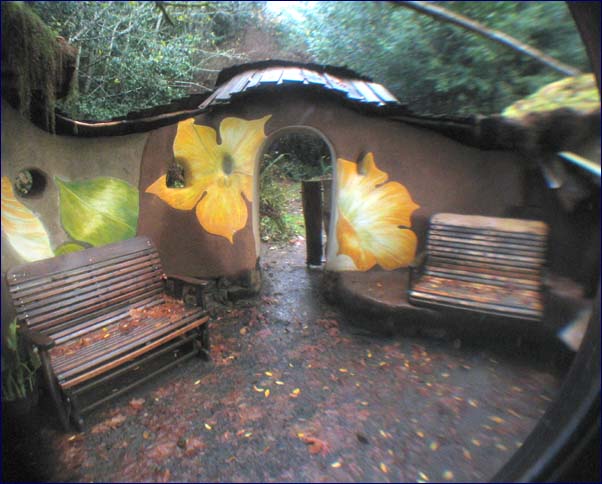
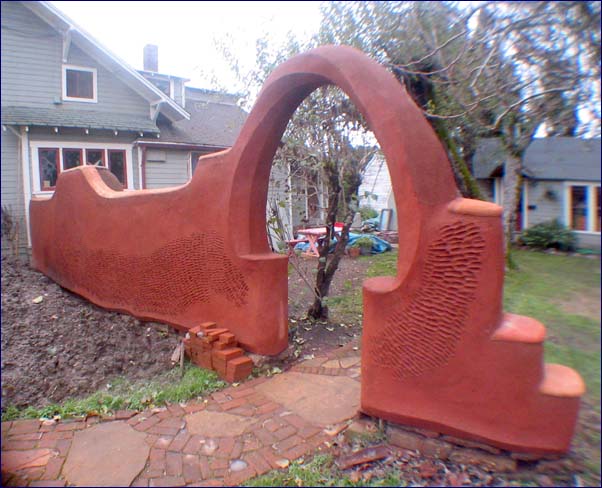
AND NOW WE TURN OUR attention to open-air Rumford fireplaces. Ah, there's nothing that comes even remotely close to sitting around the fire, warming your toes, watching the flickering flames do their infinite dance, and maybe roasting potatoes in tin foil, or jelly marshmellows, if you're so inclined. Of course you can just dig a pit in the ground and put a couple of rocks around in a circle to protect it from gusts of wind. But then you're losing 99% of the energy that's bring burned, so you're colder than you want to be, and wasting precious trees, as well. However, if you build a cob wall behind the fire, that heat will be absorbed by the wall and reflected back at you, making much more efficient use of the fossil fuels, and keeping you toasty warm, to boot. Anthropologists have even surmised that the earthen fireplace is actually the forebearer of the house -- our ancestors didn't build houses and then decide one day to bring the fire inside the house; rather, they first built earthen fireplaces, then kept adding on to the walls of the fireplace, until they enclosed the inhabitants in a house! So it's in everyone's genetic memory to sit outside by the fire and gaze up at the stars.
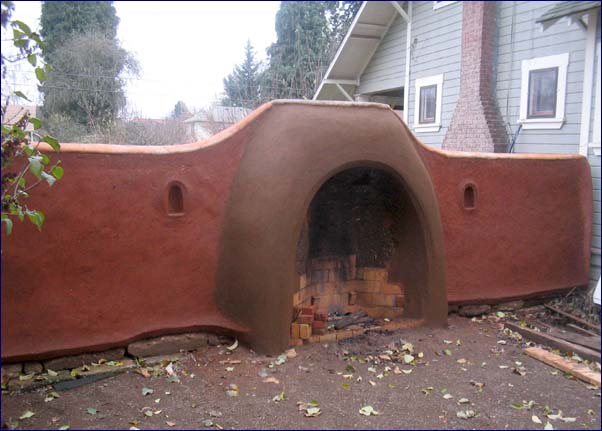
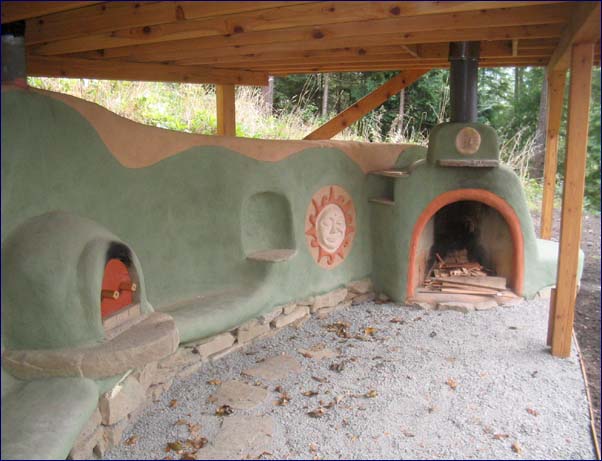
THE LAST EARTHEN STRUCTURE that we will look at today is the cob oven. Have you ever eaten a pizza made in an earthen oven? Or perhaps you've have the opportunity to bake a challah bread in an old-school oven made out of real bricks, not moving metal parts? If you have, then you know that there's no comparison, it tastes way better than Pizza Pizza ever thought possible. The oven will take longer to get hot, but once it reaches the requisite heat, it bakes the pizza at a much higher temperature, from all sides. If you're a food connoisseur, you should not be without one of these in your backyard. Nothing says I love you like freshly baked croissants first thing in the morning! Trust me, I know -- my grandfather was a baker! The basic structure is the same every time -- a hemispherical dome raised off the ground onto some kind of rock-hard platform -- but it can be embellished in any which way you like, just like every other cob structure. Mm-mm, yum...
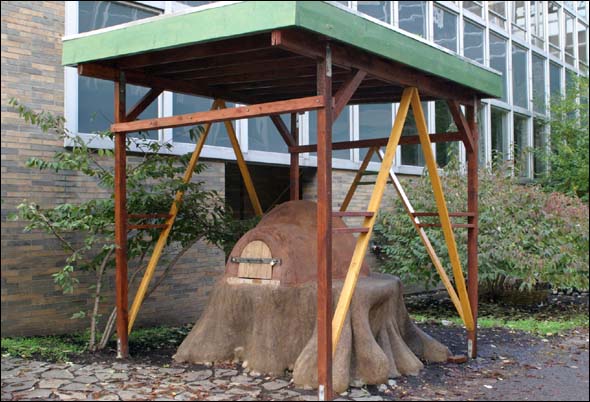
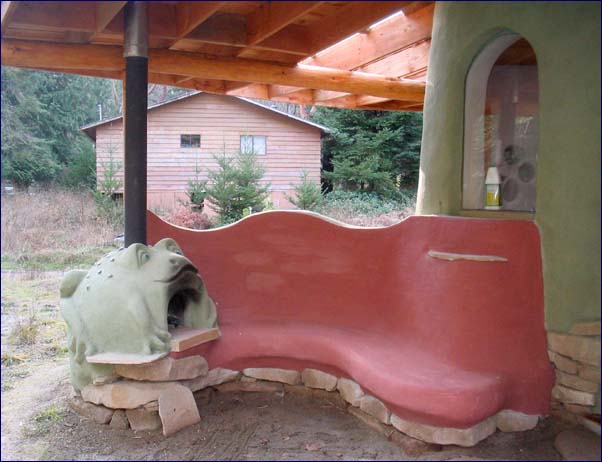
AS YOU'VE PROBABLY NOTICED, all of these cob projects have been built on the West Coast, there are precious few of them on the East Coast up in Canada. But a few months after we built the Spark Bench, the first cob project in Toronto, Georgie Donais spearheaded dozens of volunteers to build a sprawling cob complex for food preparation and outdoor play at Dufferin Grove Park, just south of Bloor Street. The project was so successful that it spawned a series of cob benches and other structures in the area. Cob in the Park is an incredible example of what cob is capable of, and I encourage you to head down there, especially now as the leaves are changing colours, to see for yourself what's possible with a little bit of creativity, and a lot of love. Cob may not have made waves in the mainstream, but for hardcore ecologists, it's one of the best ways that you can alter your environment and walk the talk. So if you embrace earth building right now, you'll be one of the first few that will be able to boast about beautiful cob in your own backyard.
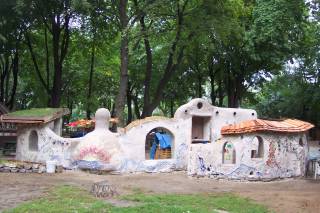
|

